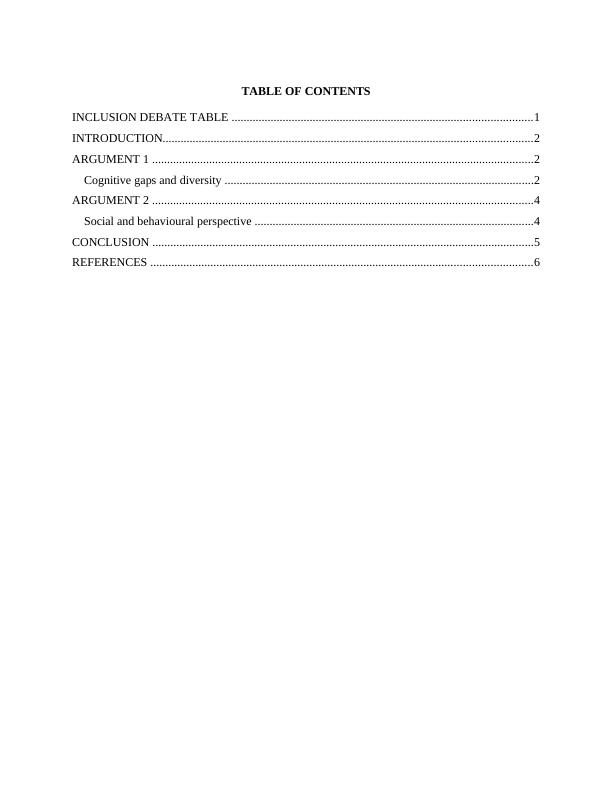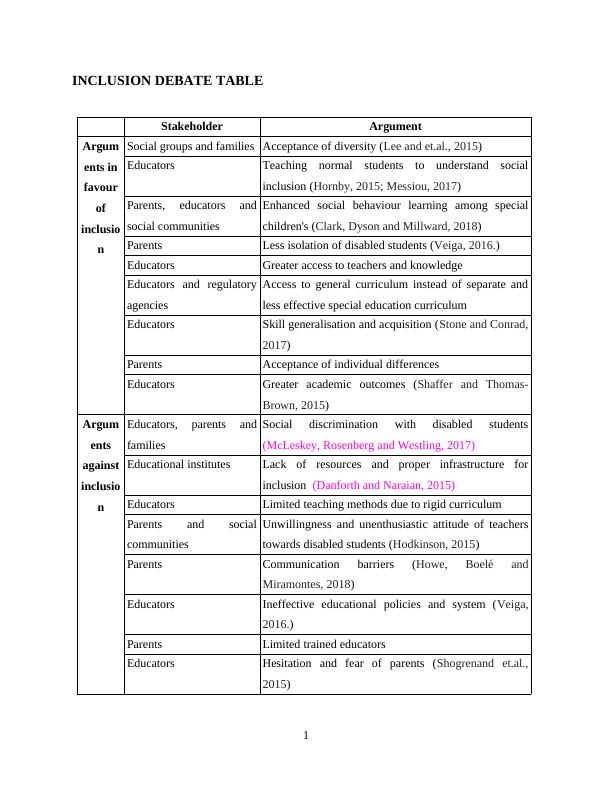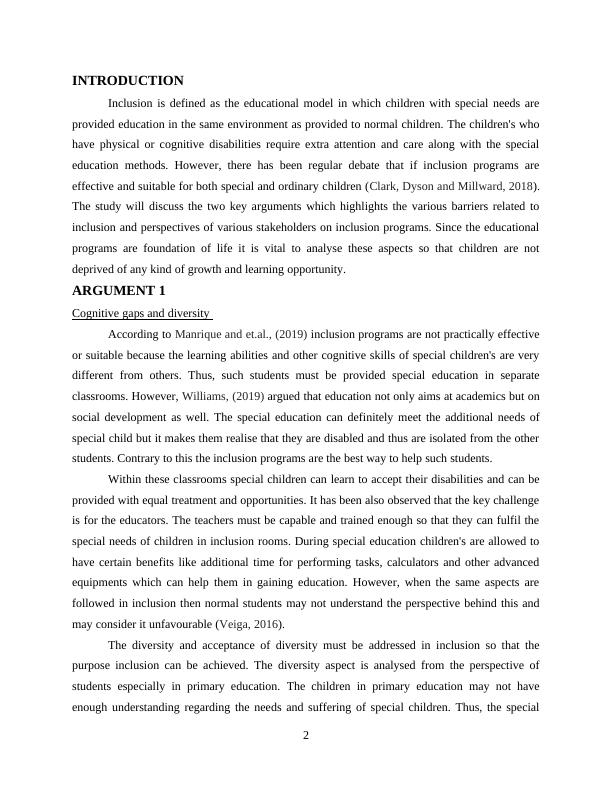Social and Behavioural Perspective Essay
Added on 2020-11-12
14 Pages2789 Words339 Views
ESSAY

TABLE OF CONTENTSINCLUSION DEBATE TABLE ....................................................................................................1INTRODUCTION...........................................................................................................................2ARGUMENT 1 ...............................................................................................................................2Cognitive gaps and diversity .......................................................................................................2ARGUMENT 2 ...............................................................................................................................4Social and behavioural perspective .............................................................................................4CONCLUSION ...............................................................................................................................5REFERENCES ...............................................................................................................................6

INCLUSION DEBATE TABLE Stakeholder Argument Arguments infavourofinclusion Social groups and familiesAcceptance of diversity (Lee and et.al., 2015)Educators Teaching normal students to understand socialinclusion (Hornby, 2015; Messiou, 2017)Parents, educators andsocial communities Enhanced social behaviour learning among specialchildren's (Clark, Dyson and Millward, 2018)Parents Less isolation of disabled students (Veiga, 2016.)Educators Greater access to teachers and knowledge Educators and regulatoryagencies Access to general curriculum instead of separate andless effective special education curriculum Educators Skill generalisation and acquisition (Stone and Conrad,2017)Parents Acceptance of individual differences Educators Greater academic outcomes (Shaffer and Thomas-Brown, 2015)Argumentsagainstinclusion Educators, parents andfamilies Social discrimination with disabled students(McLeskey, Rosenberg and Westling, 2017)Educational institutes Lack of resources and proper infrastructure forinclusion (Danforth and Naraian, 2015)Educators Limited teaching methods due to rigid curriculum Parents and socialcommunities Unwillingness and unenthusiastic attitude of teacherstowards disabled students (Hodkinson, 2015)Parents Communication barriers (Howe, Boelé andMiramontes, 2018)Educators Ineffective educational policies and system (Veiga,2016.)Parents Limited trained educators Educators Hesitation and fear of parents (Shogrenand et.al.,2015)1

INTRODUCTIONInclusion is defined as the educational model in which children with special needs areprovided education in the same environment as provided to normal children. The children's whohave physical or cognitive disabilities require extra attention and care along with the specialeducation methods. However, there has been regular debate that if inclusion programs areeffective and suitable for both special and ordinary children (Clark, Dyson and Millward, 2018).The study will discuss the two key arguments which highlights the various barriers related toinclusion and perspectives of various stakeholders on inclusion programs. Since the educationalprograms are foundation of life it is vital to analyse these aspects so that children are notdeprived of any kind of growth and learning opportunity. ARGUMENT 1Cognitive gaps and diversity According to Manrique and et.al., (2019) inclusion programs are not practically effectiveor suitable because the learning abilities and other cognitive skills of special children's are verydifferent from others. Thus, such students must be provided special education in separateclassrooms. However, Williams, (2019) argued that education not only aims at academics but onsocial development as well. The special education can definitely meet the additional needs ofspecial child but it makes them realise that they are disabled and thus are isolated from the otherstudents. Contrary to this the inclusion programs are the best way to help such students. Within these classrooms special children can learn to accept their disabilities and can beprovided with equal treatment and opportunities. It has been also observed that the key challengeis for the educators. The teachers must be capable and trained enough so that they can fulfil thespecial needs of children in inclusion rooms. During special education children's are allowed tohave certain benefits like additional time for performing tasks, calculators and other advancedequipments which can help them in gaining education. However, when the same aspects arefollowed in inclusion then normal students may not understand the perspective behind this andmay consider it unfavourable (Veiga, 2016). The diversity and acceptance of diversity must be addressed in inclusion so that thepurpose inclusion can be achieved. The diversity aspect is analysed from the perspective ofstudents especially in primary education. The children in primary education may not haveenough understanding regarding the needs and suffering of special children. Thus, the special2

End of preview
Want to access all the pages? Upload your documents or become a member.
Related Documents
Inclusive Teaching and Learning Assignmentlg...
|20
|4724
|162
Inclusive Practices in Education for Students with Special Needslg...
|12
|2617
|230
Inclusive Curriculum for Early Childhood Educationlg...
|5
|1112
|346
Inclusive Learning in Early Childhood Education: Perspectives, Legislation, and Developmental Theorieslg...
|12
|4220
|247
Inclusive Studies: Strategies for Children with Special Needslg...
|17
|4048
|202
Educational Handout Report 2022lg...
|6
|567
|21
